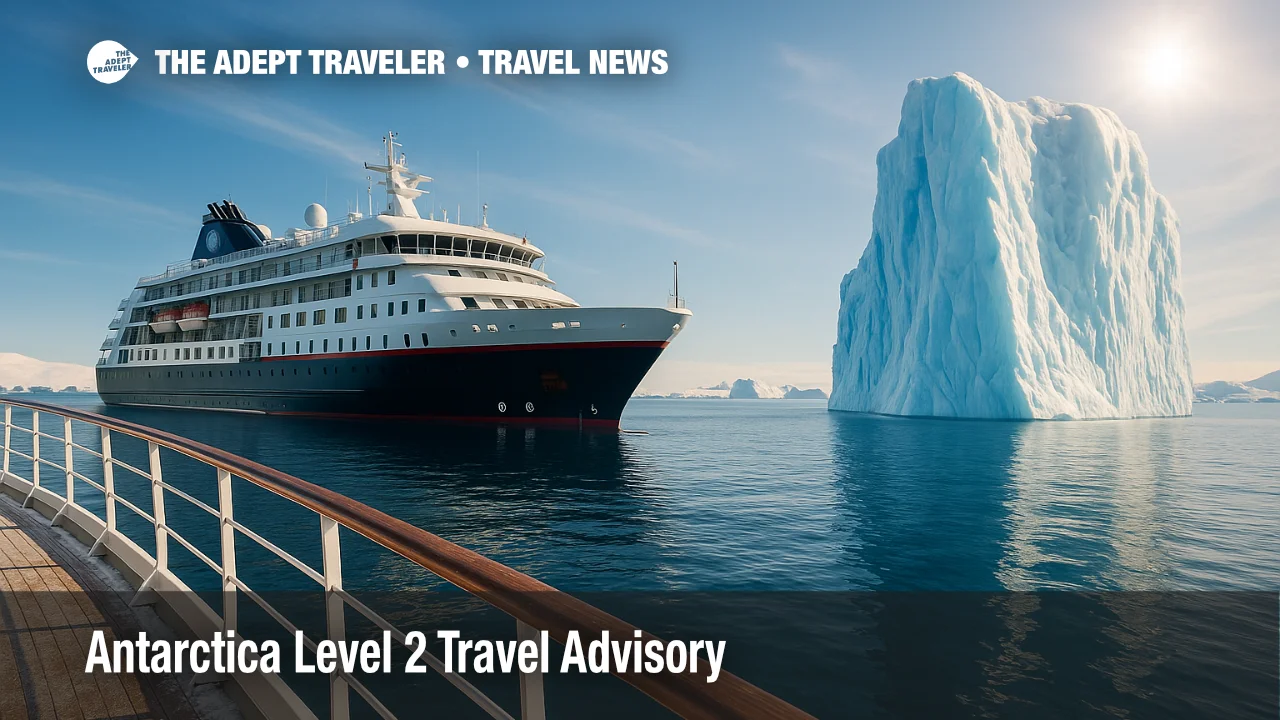Antarctica Level 2 Travel Advisory

U.S. travelers eyeing an Antarctic expedition received a timely reminder of the continent's unforgiving nature this week. On July 28 the State Department reissued its Level 2 travel advisory for Antarctica, urging visitors to exercise increased caution amid extreme, fast-changing weather and very limited emergency support. The update stops short of discouraging travel but stresses that rescue assets are scarce and that no U.S. consular services operate south of 60° S. The guidance underscores the importance of preparation before boarding even the most luxurious polar cruise.
Key Points
- Why it matters: Antarctic visitor numbers keep rising, yet rescue capacity remains thin across vast distances.
- Advisory stays at Level 2; the notice encourages caution rather than imposing new restrictions.
- No U.S. embassies on continent; nearest help lies in Argentina, Chile, Australia, New Zealand, or South Africa.
- Officials urge comprehensive evacuation insurance and tours run by IAATO-member operators.
- Travelers should enroll in STEP and carry detailed contingency plans for weather disruptions.
Snapshot
Antarctica's appeal has soared in recent years, with expedition operators reporting more than 105 000 visitor arrivals during the 2023-24 austral summer, according to the International Association of Antarctica Tour Operators. While most guests sail the Drake Passage on modern ships with ice-class hulls, rescue assets remain hundreds of miles away. Severe katabatic winds can erupt without warning, grounding aircraft and closing landing zones. Because the advisory is a reissue rather than a downgrade, travelers face no new entry protocols. Instead, officials note that a single private medical-evacuation flight can cost ¥1 000 000 JPY (about $7 000 USD) per flight hour, and cruise lines typically require proof of such coverage before embarkation.
Background
Washington has classified Antarctica as Level 2 since the four-tier travel-advisory system debuted in 2018. The continent is governed by the 1959 Antarctic Treaty, which bans permanent settlements and leaves research stations as the only year-round human presence. The United States Antarctic Program maintains bases at McMurdo and Amundsen-Scott South Pole, but its mission is scientific, not consular. Expedition cruises operate only during the brief austral summer, when sea ice retreats. IAATO, a voluntary trade group, sets wildlife-distance rules, biosecurity measures, and passenger-landing limits. More than 50 operators representing roughly 100 vessels follow the code, providing travelers a measure of industry self-regulation in a region beyond national jurisdiction.
Latest Developments
Insurance and Contingency Requirements
The revised notice reiterates the need for comprehensive travel insurance that covers medical evacuation, trip interruption, and potential quarantine delays. Because Antarctica lies outside most national search-and-rescue zones, operators often rely on chartered aircraft based in Punta Arenas or Christchurch. Policies must spell out evacuation limits, reimbursement timelines, and coverage for pre-existing conditions. Travelers booking private yacht charters must show independent proof of evacuation funding, and many insurers now request a vessel-safety certificate before underwriting. Officials also recommend packing satellite phones or two-way text messengers as backups to shipboard connectivity.
STEP and Remote Communication Tools
The advisory urges travelers to enroll in the Smart Traveler Enrollment Program so alerts can be relayed through nearby embassies if an incident unfolds. Cruise lines increasingly offer pre-departure STEP sign-ups during embarkation briefings, and several expedition operators have adopted low-bandwidth email portals that remain functional when dedicated Starlink terminals go offline. The Department of State further suggests carrying laminated copies of emergency numbers for Argentine and Chilean naval rescue coordination centers, which direct most Antarctic SAR calls.
Analysis
Reissuing, rather than upgrading, the Level 2 advisory reflects a balancing act between acknowledging Antarctica's hazards and recognizing the mature protocols that expedition operators have developed. Visitor numbers remain well below mainstream destinations, yet a sudden spike in demand for luxury "last-continent" itineraries means more first-time polar cruisers are entering the market. Many assume that a modern ship equates to hospital-grade safety, overlooking the logistical reality that the closest trauma center may be 1 000 miles away. Climate-driven shifts add complexity, with warmer summers extending sailing windows but also destabilizing ice shelves, which can create ad-hoc growler fields that impede evacuation routes. The advisory's emphasis on insurance and contingency planning signals that the government expects travelers to bear primary responsibility for their own rescue. It also nudges operators to maintain IAATO participation, an informal mechanism that fills a regulatory void where national jurisdiction is limited. For U.S. travel advisors, the notice is a prompt to verify clients' coverage details and to highlight itineraries that include onboard doctors and redundant propulsion systems.
Final Thoughts
Antarctica remains an alluring bucket-list journey, but it demands respect for its isolation and volatility. Comprehensive insurance, experienced IAATO-affiliated guides, and proactive enrollment in STEP form a safety trio that can turn a crisis into a manageable inconvenience. Travelers willing to prepare thoroughly will still find the white continent's wildlife, ice formations, and endless twilight as captivating as ever-just make sure every plan acknowledges the realities underscored by the latest Antarctica travel advisory.
